Insights can be very helpful during such exploratory tests. Victor could have run Insights on the test robot and used the real-time visual feedback to validate his design ideas and collect data to gradually improve the design of the robot cell.
Since Continental’s first project, they have added eight more cobots to their line. For these subsequent projects, they could also have used the data they had collected from the first application to inform their choices about new projects.
How to use data in the integrate phase
Insights is very helpful during the Integrate phase. Participants of our RUC 24 Hour Challenge back in September — in which eight teams integrated a robotic production line in just one day — used Insights to monitor and tweak their robot application as it was developed. Insights data used at this stage can help you to quickly identify problems in the robot programming and see where the robot is wasting time.
Continental could have used Insights during this early stage of deployment to closely monitor the robot’s operation and iron out any teething problems with the design. Also, one of the biggest challenges during integration occurs when robots are not communicating properly. Insights can help to overcome this challenge, as we discussed in the article How to Ensure Your Cells Are Talking to Each Other.
Case study 2: Walt Machine Inc
WALT Machine Inc’s president, Tommy Caughey, first saw Universal Robots about 4 to 6 years ago and was very impressed. However, it wasn’t until 2016 that he decided to make the jump and buy one for his business. What was it that convinced him? The Robotiq Plug + Play Wrist Camera that we brought out that year!
The robot allowed him to go away for 4-6 hours and leave the robot running, unattended, overnight. Most of the time, the robot easily achieved this and there were no break-downs. However, he was always a little bit worried that the robot make down.
That was, until Insights came along!
![]()

How to use notifications in the operate phase
The Operate phase is when Insight’s instant SMS and email notifications become a real help. When we released the software, Tommy Caughey added Insights to his robot. He now receives updates from the robot, sent straight to his mobile phone, when he’s at his desk.
His team no longer have to manually count the number of parts made during the night shift, which frees up time to learn new skills and develop new robot applications using the data from Insights.
How to use data in the operate phase
The Operate phase is where you collect the largest amount of data, which can be useful in several ways. Three of these are:
Validate the project — Both Continental and Walt Machine Inc, could have used Insights to demonstrate that the project was success. While they were able to show a 50% changeover time improvement using their existing analytics, they could also have shown more detail by analyzing the cobot-specific KPIs used in Insights.
Continuous improvement — There are always improvements that can be made to a robot process. Insights provides a simple way to analyze and identify areas for improvement. Both companies could have tracked their robot cell and improved productivity even further.
Seek out new projects — Finally, as the Continental case study showed, your first robot application is often only the start. The data you collect from Insights can help you to start building your next automation project and ensure it will be a success.
You can try out Insights for yourself within a matter of minutes by going to the Insights Demo. Also, if you are considering a new automation project, Blueprints is a great way to get started as it will help you to clarify the application before you begin designing the robot cell.
This post was republished with permission from Robotiq.
